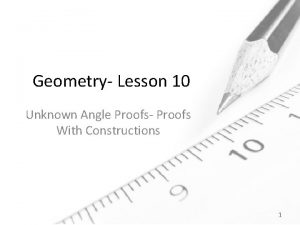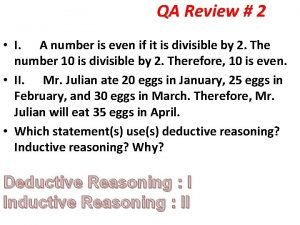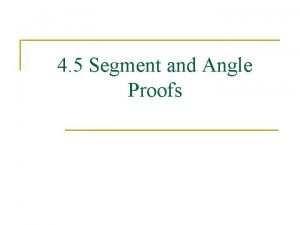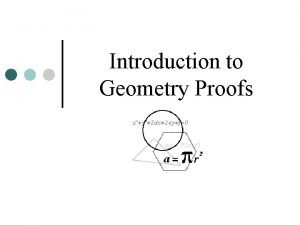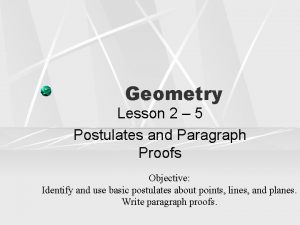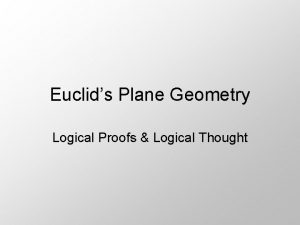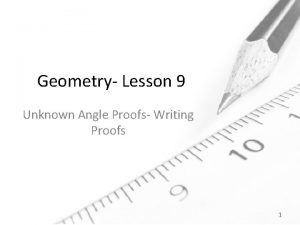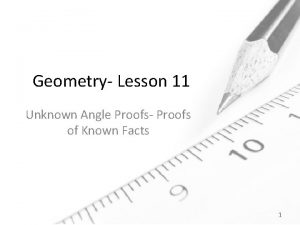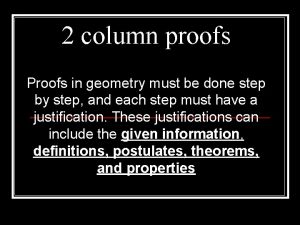Euclids Plane Geometry Logical Proofs Logical Thought History








- Slides: 8

Euclid’s Plane Geometry Logical Proofs & Logical Thought

History • Thales (600 BC) – First to turn geometry into a logical discipline. – Described as the first Greek philosopher and the father of geometry as a deductive study. – Relied on rational thought rather than mythology to explain the world around him. • Pythagoreans and other Greeks continued this rational train of thought.

History • By the time of Euclid many things had been proved by Greek mathematicians. – However, these proofs were disorganized, each one starting from its own set of assumptions. • Euclid organized many of these proofs and more that he came up with in his work Elements.

The Elements • Composed of thirteen parts or “books” (probably long papyrus scrolls) – Books I – IV & VI are on plane geometry. – Books V & X are about magnitudes and ratios. – Books VII – IX are about whole numbers. – Books XI – XIII are about solid geometry. • These thirteen books contained a total of 465 “propositions” or theorems. – Had a figure corresponding to each proposition followed by a careful proof. – The proof then ends with a restatement of the original proposition to be proved.

The Elements • What to base the proofs off of? – Euclid starts off with a long list of 23 definitions of concepts that can be agreed upon • i. e. points, lines, planes, etc. – Then, drawing form Aristotle, Euclid states 10 axioms on which to base his logic system • 5 common notions that everyone would agree with. • 5 postulates relating to geometry which Euclid took to be intuitively true. – According to Aristotle, a logic system must begin with a some basic assumptions that we take for granted on which we build the system.

Relevance • Euclid’s Elements was not just a mathematical step forward but was also a step forward in logical thinking. • Things based on or influenced by the ideas of Euclid’s Elements: • Descartes philosophical method. – Moving from basic principles to complex conclusions. • Newton and Spinoza used the form of Euclid’s Elements to present their ideas. • Abraham Lincoln carried a copy of Elements with him in order to be a better lawyer. • The Declaration of Independence is based on “self evident” axioms used to prove the colonies are justified in forming the United States of America.

Euclid Today • Today, a modified form of Euclid’s Elements is used as the curriculum for sophomores in high school although the logic is slightly de-emphasized. • The logic of Euclid’s Elements is valid in many parts f modern life: – Such as collective bargaining agreements, computer systems, software development, and dealing with social-political arguments. • Basically, Euclid developed a way of organizing ideas in a logical manner that is still relevant today.

References • http: //www. es. flinders. edu. au/~mattom/science+society/lectures/illus trations/lecture 8/thales. html • http: //schools. techno. ru/sch 758/geometr/Euclid. htm • http: //www. smokelong. com/images/euclid. jpg • W. P. Belinghoff, F. Q. Gouvêa. (2002). Math Through The Ages. Oxton House Publishers, LLC: Farmington, ME. • http: //www. whatreallyhappened. com/DECLARATION/us_declaration E. jpg • http: //www. cooperativeindividualism. org/lincoln-abraham. jpg • http: //www. siu. edu/~pulfrich/Pulfrich_Pages/lit_pulf/nick_thm/Parabo la. gif

